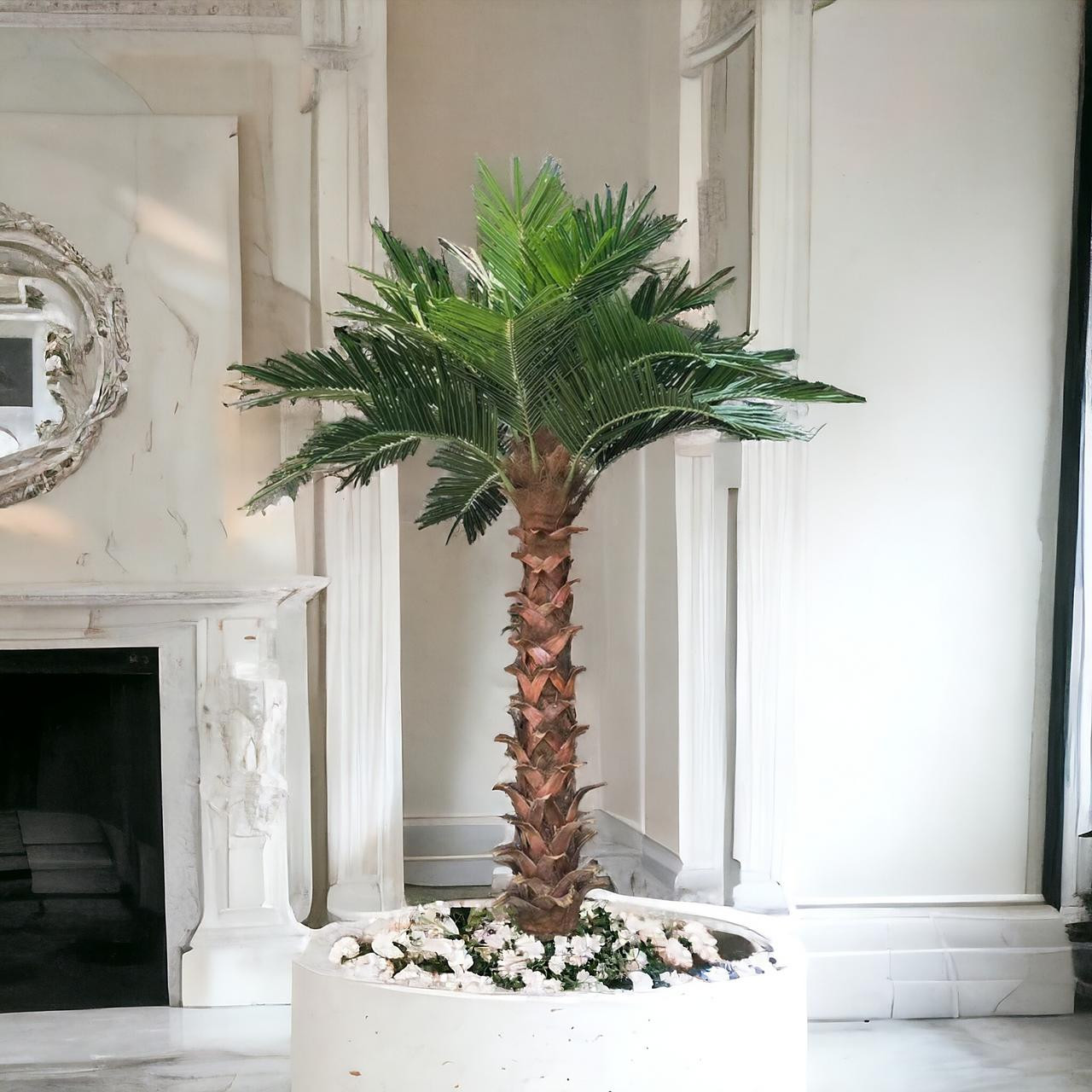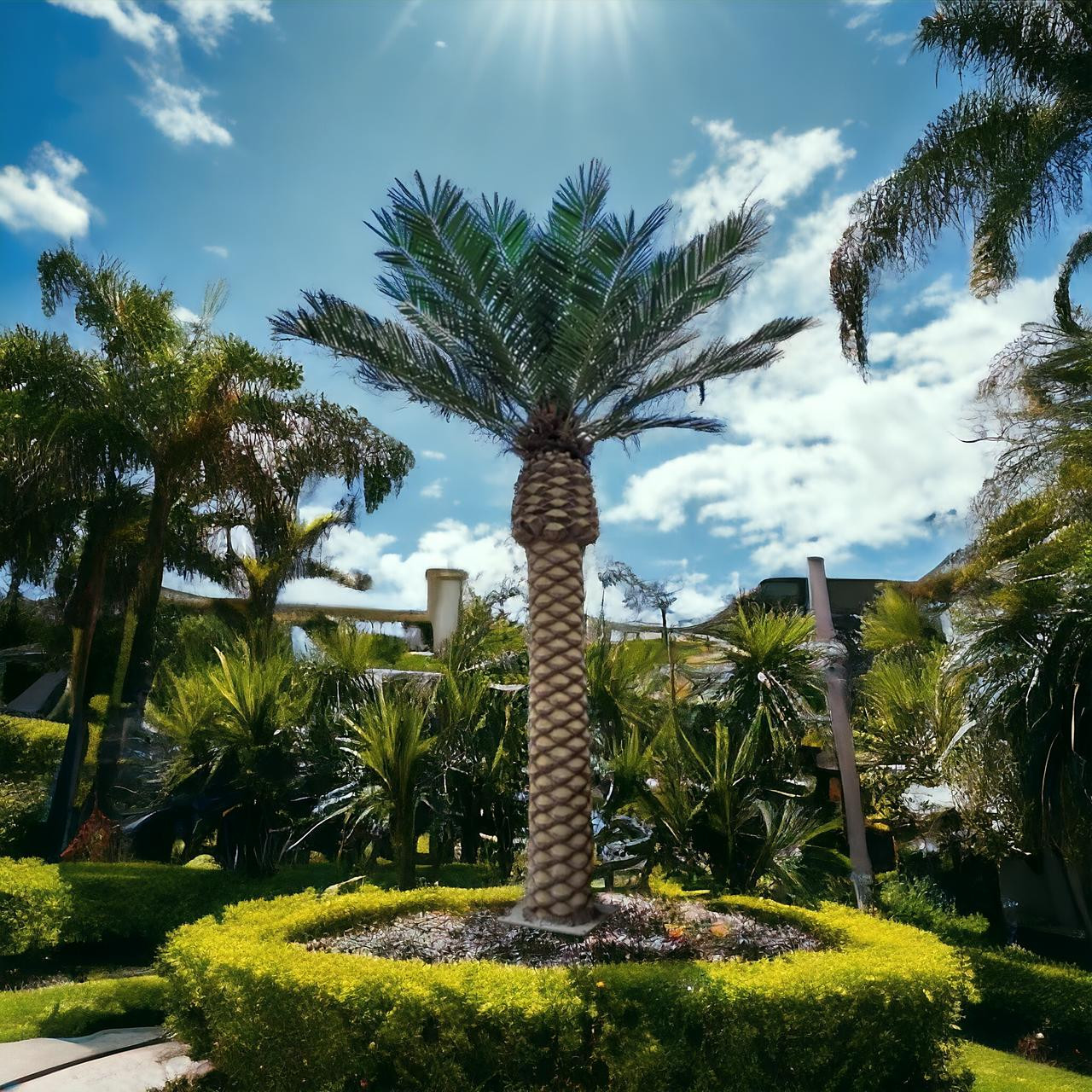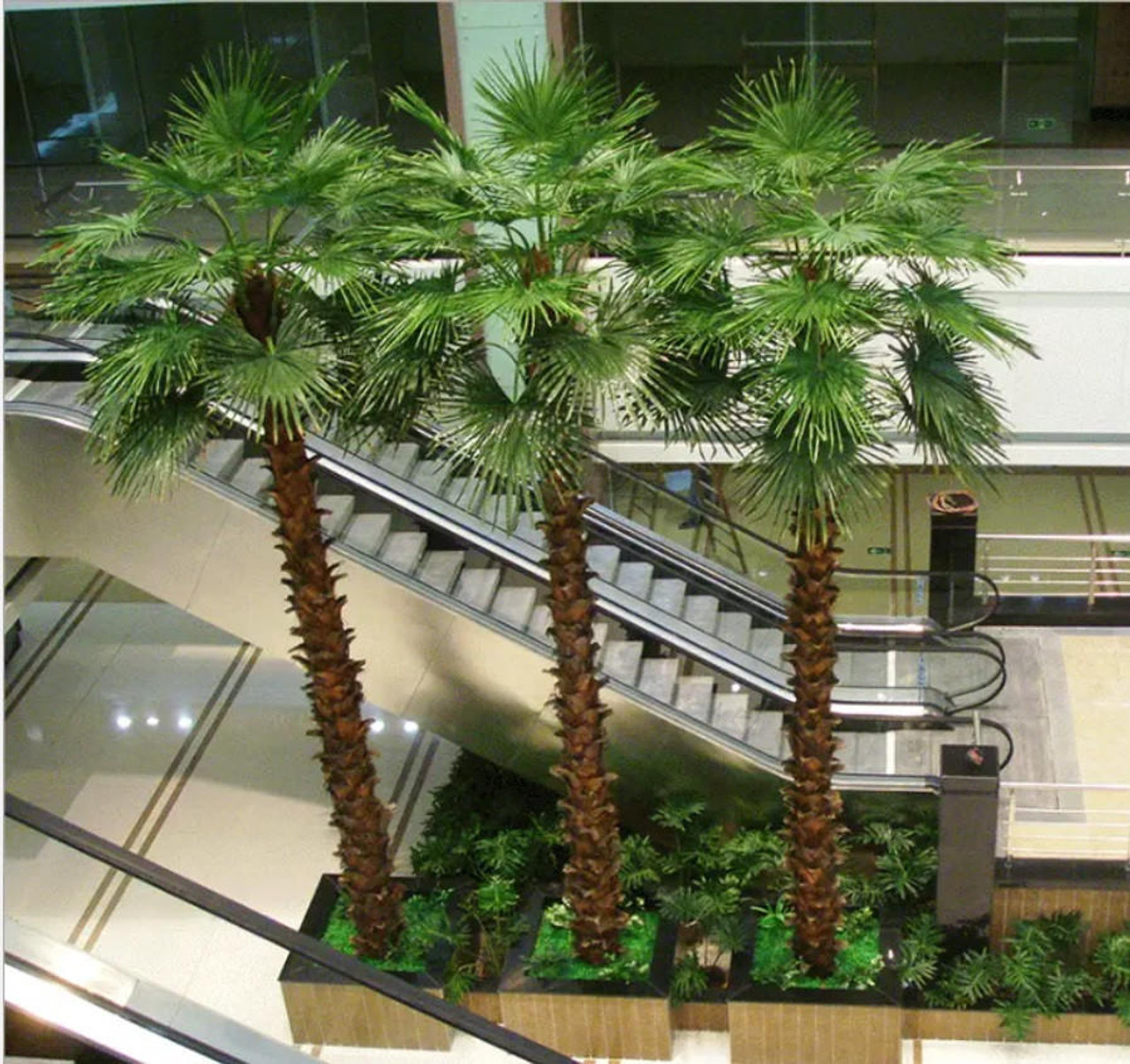Imitation Palm Trees vs. Real Palm Trees: Pros, Cons, and What You Need to Know Before Choosing
Sep 01, 2024
When envisioning a tropical paradise, palm trees are one of the first images that come to mind. Their iconic silhouettes evoke feelings of relaxation, luxury, and exotic destinations. However, bringing that tropical vibe to your home, business, or urban space requires a crucial decision: should you opt for real palm trees or imitation palm trees?
Both options have their unique advantages, but in many scenarios, imitation palm trees can offer significant benefits that outshine their real counterparts. In this comprehensive guide, we’ll explore the pros and cons of each, focusing on key factors such as cost, maintenance, durability, environmental impact, and aesthetic appeal. By the end, you’ll have a clearer understanding of why imitation palm trees might be the better choice for your needs.
Cost: Initial Investment vs. Long-Term Expenses
Real Palm Trees
Real palm trees can vary widely in price depending on the species, size, and location. Smaller, younger palms might be relatively inexpensive, but as the tree size increases, so does the cost. Additionally, transporting and planting a real palm tree can be an expensive endeavor, especially for larger specimens.
However, the initial purchase price is just the beginning. Real palm trees require ongoing maintenance, including watering, fertilizing, pruning, and pest control. These recurring costs can add up significantly over the lifespan of the tree. In areas where palm trees are not native, you might also face additional costs related to protecting the trees from cold weather, which can be detrimental to many palm species.
Imitation Palm Trees
Imitation palm trees, on the other hand, typically have a higher initial cost compared to smaller real palms. The price of an imitation palm tree depends on the size, materials, and level of detail. However, this is generally a one-time expense. Once installed, imitation palm trees require little to no maintenance, translating to significant long-term savings.
There are no costs associated with watering, fertilizing, or pruning, and you won’t need to worry about pests or diseases. Over time, this can make imitation palm trees a more cost-effective option, particularly for large-scale projects or installations in environments where real palms might struggle to thrive.
Verdict: While the initial cost of imitation palm trees might be higher, the long-term savings on maintenance and care often make them a more economical choice, especially in non-tropical climates.
Maintenance: Time and Effort Required
Real Palm Trees
Maintaining real palm trees requires a consistent effort. These trees need regular watering, particularly in dry climates, to ensure they remain healthy and vibrant. Fertilization is also crucial, as palms require specific nutrients to thrive. Additionally, palm fronds will need to be pruned regularly to remove dead or damaged leaves, which can be both a time-consuming and hazardous task, especially for taller trees.
Moreover, real palm trees are susceptible to various pests and diseases, which may require treatments ranging from organic solutions to chemical pesticides. If you live in a region with cold winters, you might need to take additional steps to protect your palm trees from frost damage, including wrapping them or providing heat sources.
Imitation Palm Trees
Imitation palm trees are virtually maintenance-free. Once installed, they require no watering, fertilizing, or pruning. There’s no need to worry about pests, diseases, or weather conditions, as these trees are built to withstand a wide range of environments without any special care.
Occasionally, you might need to clean imitation palm trees to remove dust or debris, especially if they are placed in outdoor settings. This can be done easily with a hose or a simple wipe-down. The absence of regular maintenance tasks makes imitation palm trees an ideal choice for those who want the aesthetic appeal of palm trees without the ongoing commitment of care.
Verdict: Imitation palm trees are the clear winner when it comes to maintenance. They require little to no effort, making them a hassle-free option for busy property owners or managers.
Durability: Longevity and Resilience
Real Palm Trees
Real palm trees, depending on the species and the environment, can live for many years, with some varieties thriving for decades. However, their longevity is heavily influenced by factors such as climate, soil quality, water availability, and overall care. In regions where palm trees are not native, they may struggle to survive due to unsuitable conditions.
Real palm trees are also vulnerable to extreme weather conditions. High winds, heavy rains, or cold snaps can damage or even kill these trees. Additionally, their root systems, while extensive, are relatively shallow, making them more susceptible to being uprooted during storms.
Imitation Palm Trees
Imitation palm trees are designed to be incredibly durable. Made from materials like UV-resistant plastics, fiberglass, or metal, these trees are built to withstand harsh weather conditions, including strong winds, heavy rains, and extreme temperatures. They are not subject to the same environmental stresses as real palm trees, making them an ideal choice for locations where real palms might not survive.
Another advantage of imitation palm trees is their consistent appearance. They do not age, wither, or lose their leaves, ensuring that they maintain their visual appeal year after year. With proper installation and minimal care, imitation palm trees can last for decades without showing signs of wear.
Verdict: In terms of durability, imitation palm trees are superior. They are built to last and can endure a wide range of conditions without degradation, making them a reliable long-term investment.
Environmental Impact: Sustainability and Eco-Friendliness
Real Palm Trees
Real palm trees are living organisms that contribute to the environment by producing oxygen, sequestering carbon dioxide, and providing habitats for various species. In their native habitats, they play a crucial role in the ecosystem. However, when planted outside their natural range, they can have mixed environmental impacts.
In non-native environments, maintaining real palm trees can be resource-intensive. The water needed to keep these trees healthy can be significant, particularly in arid regions. The use of fertilizers and pesticides can also contribute to environmental pollution. Additionally, the carbon footprint associated with transporting large palm trees from nurseries to their final destinations can be substantial.
Imitation Palm Trees
Imitation palm trees, while not living plants, can be a more environmentally friendly option in certain contexts. They require no water, fertilizers, or pesticides, reducing their overall environmental footprint. Furthermore, many imitation palm trees are now made from recycled or sustainable materials, making them an even greener choice.
One of the significant environmental benefits of imitation palm trees is their potential to contribute to sustainable urban planning. By reducing the need for water and chemicals, they help conserve resources and minimize pollution. Additionally, because they are not subject to the same risks as real trees, they can be used in areas where real trees might not survive, helping to green spaces that would otherwise remain barren.
Verdict: While real palm trees offer environmental benefits in their native habitats, imitation palm trees can be more sustainable in non-native or resource-scarce environments. Their low resource requirements and potential use of recycled materials make them a green choice for eco-conscious consumers.
Aesthetic Appeal: Realism vs. Artistic Flexibility
Real Palm Trees
There’s no denying the natural beauty of a real palm tree. The way their fronds sway in the breeze and the organic variations in their leaves and trunks contribute to a sense of authenticity and connection with nature. Real palm trees bring a living, breathing piece of the tropics into any space, creating an atmosphere that’s difficult to replicate with artificial means.
However, real palm trees are not without their aesthetic drawbacks. They can be messy, dropping fronds and seeds that need to be cleaned up regularly. In some cases, they may not grow in the desired shape or size, limiting design flexibility. Moreover, real palm trees are subject to seasonal changes and may not always look their best, particularly if they are not thriving.
Imitation Palm Trees
Imitation palm trees have come a long way in recent years. High-quality artificial palms are designed to closely mimic the appearance of real trees, with realistic textures, colors, and details. From the intricate designs of the fronds to the lifelike texture of the trunk, imitation palm trees can be nearly indistinguishable from the real thing, especially from a distance.
One of the key advantages of imitation palm trees is their consistency and flexibility. They are available in a wide range of sizes, styles, and colors, allowing for complete control over the aesthetic outcome. Whether you’re looking for a towering centerpiece for an atrium or a series of smaller palms to line a walkway, imitation palm trees can be customized to fit your vision perfectly.
Additionally, imitation palm trees remain visually appealing year-round, without the mess or unpredictability of real trees. They can be installed in places where real palm trees would not grow, such as indoors or in climates where temperatures drop below freezing.
Verdict: While real palm trees offer unmatched natural beauty, imitation palm trees provide greater consistency, flexibility, and year-round appeal. For those seeking a reliable and customizable aesthetic, imitation palms are often the better choice.
Conclusion: Why Imitation Palm Trees Might Be the Better Choice
Choosing between real and imitation palm trees ultimately comes down to your specific needs, environment, and priorities. Real palm trees have their undeniable charm, contributing to the environment and bringing a touch of nature to your space. However, they also come with significant costs, maintenance requirements, and environmental considerations, particularly outside their native habitats.
Imitation palm trees, on the other hand, offer a compelling alternative. They require little to no maintenance, are highly durable, and can be more environmentally friendly in resource-scarce settings. Their consistent appearance and customizable options make them ideal for a wide range of applications, from urban landscapes to indoor decor.
For many property owners, businesses, and urban planners, imitation palm trees provide the perfect balance of aesthetic appeal, practicality, and sustainability. Whether you’re looking to create a tropical oasis in a city center or simply want to add a touch of greenery to your indoor space without the hassle, imitation palm trees offer a versatile and long-lasting solution.
In a world where sustainability and convenience are increasingly important, imitation palm trees stand out as a smart, stylish, and eco-friendly choice. So before you invest in a real palm tree, consider the long-term benefits of going artificial—you might just find that imitation is the perfect solution for your needs.





